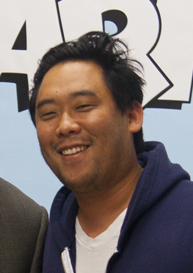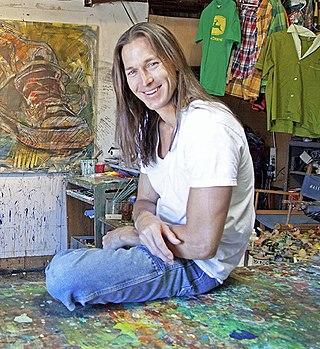An entertainment robot is, as the name indicates, a robot that is not made for utilitarian use, as in production or domestic services, but for the sole subjective pleasure of the human. It serves, usually the owner or his housemates, guests, or clients. Robotic technologies are applied in many areas of culture and entertainment.
Crystal Dynamics, Inc. is an American video game developer based in San Mateo, California. The studio is best known for its games in the Tomb Raider, Legacy of Kain, and Gex series.

Kara Anne Swisher is an American journalist. She has covered the business of the internet since 1994. As of 2023, Swisher was a contributing editor at New York Magazine, the host of the podcast On with Kara Swisher, and the co-host of the podcast Pivot.

David Choe is an American artist, musician, actor, and former journalist and podcast host from Los Angeles. Choe's work appears in a wide variety of urban culture and entertainment contexts. He has illustrated and written for magazines including Hustler, Ray Gun and Vice. He has an ongoing relationship with the Asian pop culture website, store, and former magazine Giant Robot.

Marc Raibert is the Executive Director of the Boston Dynamics AI Institute, a Hyundai Motor Group organization that is focused on solving the most important problems in robotics and artificial intelligence to achieve fundamental advances in the engineering and science of robotics. Raibert was the founder, former CEO, and now Chairman of Boston Dynamics, a robotics company known for creating BigDog, Atlas, Spot, and Handle.

Daniel Lyons is an American writer. He was a senior editor at Forbes magazine and a writer at Newsweek before becoming editor of ReadWrite. In March 2013 he left ReadWrite to accept a position at HubSpot.

Legged robots are a type of mobile robot which use articulated limbs, such as leg mechanisms, to provide locomotion. They are more versatile than wheeled robots and can traverse many different terrains, though these advantages require increased complexity and power consumption. Legged robots often imitate legged animals, such as humans or insects, in an example of biomimicry.
Boston Dynamics, Inc., is an American engineering and robotics design company founded in 1992 as a spin-off from the Massachusetts Institute of Technology. Headquartered in Waltham, Massachusetts, Boston Dynamics has been owned by the Hyundai Motor Group since December 2020, but having only completed the acquisition in June 2021.

Orchard Supply Hardware (OSH) was an American retailer of home improvement and gardening products. Headquartered in San Jose, California, Orchard Supply Hardware had dozens of locations throughout California, with expansions into Oregon and Florida.
Good Ventures is a private foundation and philanthropic organization in San Francisco, and the fifth largest foundation in Silicon Valley. It was co-founded by Cari Tuna, a former Wall Street Journal reporter, and her husband Dustin Moskovitz, one of the co-founders of Facebook. Good Ventures adheres to principles of Effective Altruism and aims to spend most or all of its money before Moskovitz and Tuna die. Good Ventures does not have any full-time staff, and instead distributes grants according to recommendations from Open Philanthropy.

Silicon Valley Bank (SVB) is a commercial bank division of First Citizens BancShares. The bank was previously the primary subsidiary of SVB Financial Group, a publicly traded bank holding company that had offices in 15 U.S. states and over a dozen international jurisdictions.

Priscilla Chan is an American philanthropist and a former pediatrician. She and her husband, Mark Zuckerberg, a co-founder and CEO of Meta Platforms, established the Chan Zuckerberg Initiative in December 2015, with a pledge to transfer 99 percent of their Facebook shares, then valued at $45 billion. She attended Harvard University and received her medical degree from the University of California, San Francisco.
Taravat Talepasand is an American contemporary artist, activist, and educator, of Iranian descent. She is known for her interdisciplinary painting practice including drawing, sculpture and installation. As an Iranian-American woman, Talepasand explores the cultural taboos that reflect on gender and political authority. Her approach to representation and figuration reflects the cross-pollination, or lack thereof, in our Western Society. Talepasand previously held the title of the chair of the painting department at San Francisco Art Institute (SFAI). She is an assistant professor in art practice at Portland State University.
Agnieszka Kurant is a Polish interdisciplinary conceptual artist. She examines how economic, social, and cultural systems work in ways that blur the lines between reality and fiction.

Gordon Keith Smedt is an American painter from the San Francisco Bay Area. Smedt is known for his Pop art portraits of inanimate objects. His work is characterized by bold, colorful depictions of everyday objects on large canvases. He lives and works in Los Gatos, California.

Corridor Digital is an American production studio based in Los Angeles, known for creating pop-culture-related viral online short-form videos since 2010, as well as producing and directing the Battlefield-inspired web series Rush and the YouTube Premium series Lifeline. It has also created television commercials for various companies, including Machine Zone and Google.

Ai-Da is a robotic art exhibition created by British artist Aidan Meller, which has been described by its creator as "the world's first ultra-realistic humanoid robot". Completed in 2019, Ai-Da is an android incorporating computer graphics and artificial intelligence algorithms that makes drawings, paintings, and sculptures. It is named after Ada Lovelace.
Jan Rindfleisch is an American artist, educator, author, curator, and community builder. Rindfleisch is known for the programming she initiated and oversaw at the Euphrat Museum of Art; for her book on the history of art communities in the South Bay Area, Roots and Offshoots: Silicon Valley's Art Community, and for her role in documenting the careers and legacies of Agnes Pelton and Ruth Tunstall Grant.
RobotLAB is an American educational technology company that manufactures robotics and virtual reality products for K-12 and higher education, as well as business robots for retail, hospitality, and medical companies. The company distributes the Pepper and NAO humanoid robots developed by SoftBank Robotics. They are headquartered in Dallas, Texas.











